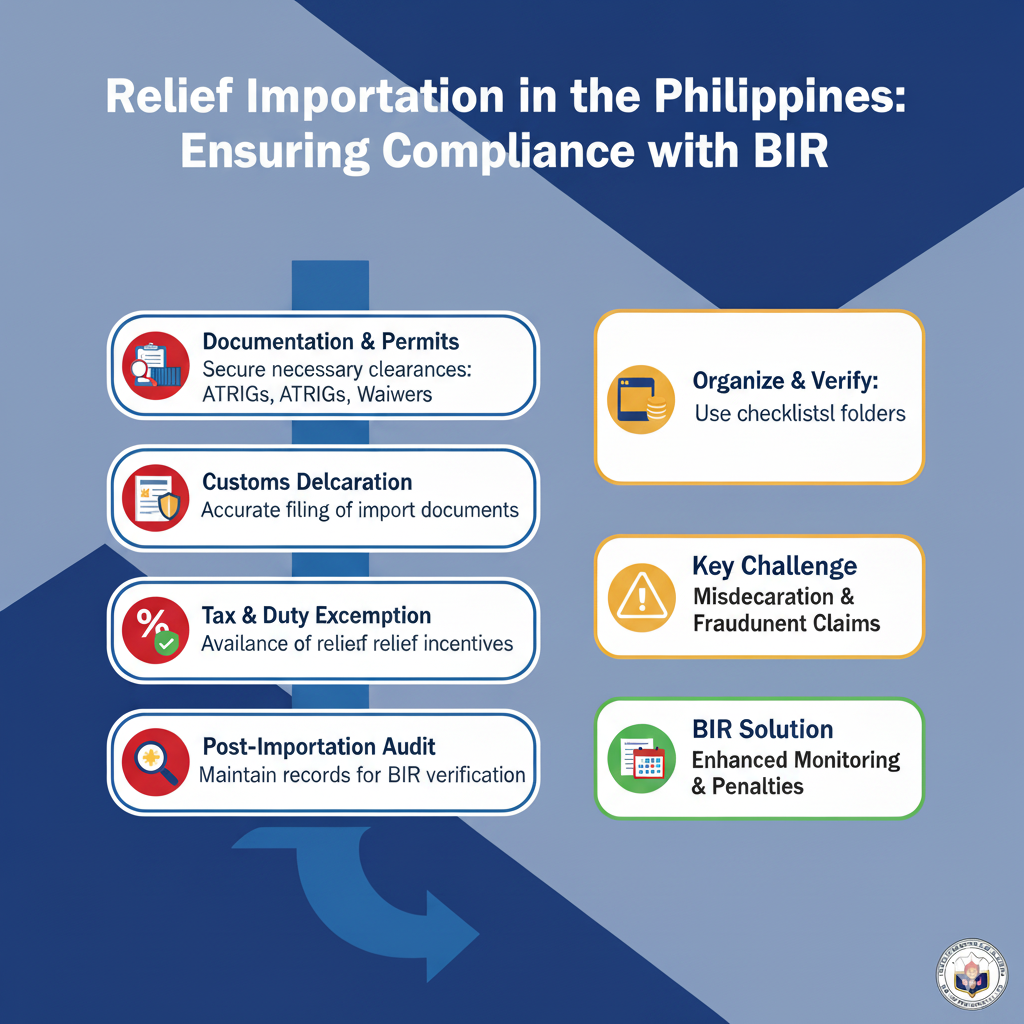For businesses engaged in importing goods into the Philippines, compliance with the Bureau of Internal Revenue (BIR) is more than just filing income tax and VAT returns. Importers are also required to submit Relief Importation reports under the BIR’s RELIEF (Reconciliation of Listings for Enforcement) System.
In this article, we’ll explore what Relief Importation is, why it matters for VAT compliance, the step-by-step filing process, and the most common mistakes businesses make when submitting their reports.
What Is Relief Importation?
Relief Importation is the report of all import transactions made by a VAT-registered taxpayer within a specific reporting period. It forms part of the electronic submissions required by the BIR for monitoring and validating VAT payments.
Purpose of Relief Importation Reporting:
- Ensures transparency of imported goods declared with the Bureau of Customs (BOC) and matched with VAT reporting to the BIR.
- Helps the BIR track Input VAT from importations.
- Prevents fraud, underreporting, or misreporting of imports.
Who Is Required to File Relief Importation?
Businesses that must file Relief Importation include:
- VAT-registered importers in the Philippines.
- Companies regularly importing goods subject to VAT.
- Businesses required to submit Summary List of Importations (SLI) quarterly.
👉 Non-VAT registered businesses are generally not required to file Relief Importation.
Step-by-Step: Filing Relief Importation with the BIR
Step 1: Collect Importation Documents
- Import Entry Declarations (Single Administrative Documents from BOC)
- Official Receipts of VAT payments on importation
- Supplier invoices and shipping documents
Step 2: Organize the Data
The Relief Importation file must include:
- Import Entry Number
- Import Date
- Supplier’s Name
- Gross Value of Importation
- VAT Paid
- Bureau of Customs Office
Step 3: Encode in the BIR Relief System
- Download and install the BIR Relief System (from the BIR website).
- Choose Summary List of Importations (SLI).
- Encode all import transactions into the system.
Step 4: Generate the Data File (.DAT)
- After encoding, generate the .DAT file required by the BIR.
- Double-check entries for accuracy.
Step 5: Submit to the BIR
- Submit the .DAT file via the BIR eSubmission portal, OR
- Provide the file to your Revenue District Office (RDO) using CD/USB if manual submission is required.
Step 6: Secure Proof of Filing
- Keep the BIR acknowledgment email (for online submissions).
- Retain a stamped receiving copy (for manual submissions).
- Store both electronic and hard copies for at least 3 years.
Common Errors in Relief Importation Filing
❌ Error 1: Incorrect Import Entry Numbers
Mismatches between Bureau of Customs (BOC) records and your Relief Importation file can trigger errors.
Fix: Verify Import Entry Numbers before submission.
❌ Error 2: Wrong VAT Amounts
If VAT paid on importation does not match what is declared in your VAT return, the BIR may flag your submission.
Fix: Cross-check VAT amounts in the SLI against Form 2550Q (Quarterly VAT Return).
❌ Error 3: Missing or Incomplete Importation Details
Failure to encode required details such as BOC office or supplier name leads to invalid files.
Fix: Ensure all fields in the Relief System are properly filled.
❌ Error 4: Late Filing
The deadline for Relief Importation filing is 30 days after the close of each quarter. Missing this can result in penalties.
Fix: Always mark deadlines and file early.
Penalties for Non-Compliance
- ₱1,000 per failure to file (capped at ₱25,000 annually).
- Risk of audit investigation by the BIR.
- Possible delay in issuance of tax clearances.
Best Practices for Relief Importation Filing
✅ Keep import documents organized and updated.
✅ Reconcile import data with VAT returns before submission.
✅ Use accounting software for easier tracking.
✅ File ahead of deadlines to avoid last-minute errors.
✅ Train staff handling BIR compliance on proper reporting.
Conclusion
Relief Importation in the Philippines is an essential requirement for VAT-registered importers. By understanding its purpose, following the step-by-step process, and avoiding common errors, businesses can ensure smooth compliance with the BIR.
Remember, proper Relief Importation filing not only avoids penalties but also strengthens your company’s credibility with tax authorities.

